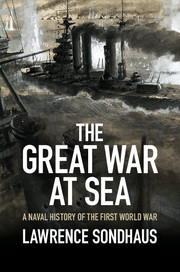Book contents
- Frontmatter
- Contents
- List of figures
- List of maps
- Acknowledgments
- Introduction
- 1 Ambition, ideology, and arms races
- 2 Preparing for war
- 3 Global prelude
- 4 European waters, 1914–15
- 5 Submarine warfare: The great experiment, 1915
- 6 Combined operations, 1915
- 7 The year of Jutland: Germany’s fleet sorties, 1916
- 8 Submarine warfare: The great gamble, 1917–18
- 9 War and revolution, 1917
- 10 Final operations
- Conclusion: Peace and naval disarmament
- Bibliography
- Index
- References
7 - The year of Jutland: Germany’s fleet sorties, 1916
Published online by Cambridge University Press: 05 August 2014
- Frontmatter
- Contents
- List of figures
- List of maps
- Acknowledgments
- Introduction
- 1 Ambition, ideology, and arms races
- 2 Preparing for war
- 3 Global prelude
- 4 European waters, 1914–15
- 5 Submarine warfare: The great experiment, 1915
- 6 Combined operations, 1915
- 7 The year of Jutland: Germany’s fleet sorties, 1916
- 8 Submarine warfare: The great gamble, 1917–18
- 9 War and revolution, 1917
- 10 Final operations
- Conclusion: Peace and naval disarmament
- Bibliography
- Index
- References
Summary
“There seems to be something wrong with our bloody ships today,” Vice Admiral David Beatty remarked to Captain Ernle Chatfield, as they stood on the bridge of HMS Lion, flagship of the Battle Cruiser Fleet. It was 16:26 on the afternoon of May 31, 1916, and the British and German navies had finally met, roughly 100 miles (160 km) west of Denmark’s Jutland peninsula, in the fleet-scale battle both had anticipated for nearly two years. The sortie by the German High Sea Fleet, now under the command of Vice Admiral Reinhard Scheer, had begun in the predawn hours of that morning, marking the third of six times between March and November 1916 that it would attempt to challenge the British Grand Fleet. Jutland was the biggest battle any German fleet would ever fight, and for the British, the biggest and most important since Trafalgar in 1805. From the Grand Fleet commander, Admiral Jellicoe, to Beatty, the squadron and ship commanders, and down to the lowliest ensign, the British naval officer corps entered the battle fully expecting a triumph as decisive as Lord Nelson’s victory over the Franco-Spanish fleet 111 years earlier. But two hours into the engagement things were not going well. Indeed, Beatty’s incredulous remark to Chatfield came in reaction to seeing the battle cruiser Queen Mary explode after being struck by a German salvo, 24 minutes after the battle cruiser Indefatigable had met the same fate. The Germans sank a third British battle cruiser, the Invincible, later in the afternoon, and would not lose a capital ship of their own until the predawn hours of the following day, during Scheer’s withdrawal to Wilhelmshaven.
- Type
- Chapter
- Information
- The Great War at SeaA Naval History of the First World War, pp. 204 - 240Publisher: Cambridge University PressPrint publication year: 2014

